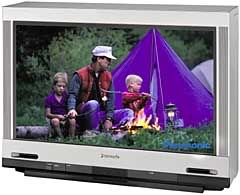HDTV is high-definition television which has a high quality resolution and aspect ratio launched in 1998. It has the highest quality in digital television standards.
2.) What is it for?
Since it has a wider aspect ratio, meaning the ratio of the film’s width to height is wider, it is possible to watch in widescreen view just like in the movie house. NTSC (National Television Standards Committee), or the American standard, employs 4:3 aspect ratio while HDTV employs 16:9. Feature films have varying aspect ratio beginning from 2:1 and above. With aspect ratios as big as this, film needs to be cropped and tampered to view in a normal television. HDTV, having a wider aspect ratio keeps these modifications at a minimum.
3.) What does it look like?

4.) What is the technology behind it?
There are three technologies that set HDTV apart from others. First is the above-mentioned aspect ratio. This aspect ratio is the reason why most HDTV sets are widescreen. The other two are the resolution and frame rate. For analog TV, the highest resolution possible if 704x480 pixels. HDTV, on the other hand, can reach up to 1920x1080 pixels. This means that it can display more pixels than an analog TV, making each detail and color more defined and thus clearer. HDTV can display 60 frames per second.
In order to use HDTV technology, there are a couple of requirements: (a.) a local, cable or satellite HDTV station source, (b.) an antenna, cable or satellite service and (c.) an HDTV set. HDTV sets may be integrated, meaning you don’t need an HDTV receiver, or it may be HDTV-ready which means that you can view analog signals with it and only view HDTV when you get a receiver.
Some complaints have been received regarding HDTV -- that it is not as clear as it promises. The reason behind this is that when HDTV receives a signal that it cannot view (i.e. analog signal), it scales the signal and de-interlaces it. Interlace means that the horizontal scan lines that makes viewing possible appear in an odd-line – even-line order interchangeably. Once it de-interlaces the analog signal, viewing is interrupted.
But if digital signals are available, clarity and a movie-quality viewing is possible. On top of that, high quality sound is also attained through Dolby AC-3 or Dolby Digital 5.1.
Sources:
http://nwfolk.com/hdtv.html. Accessed 06 August 2009.
http://electronics.howstuffworks.com/hdtv3.htm. Accessed 06 August 2009.
No comments:
Post a Comment